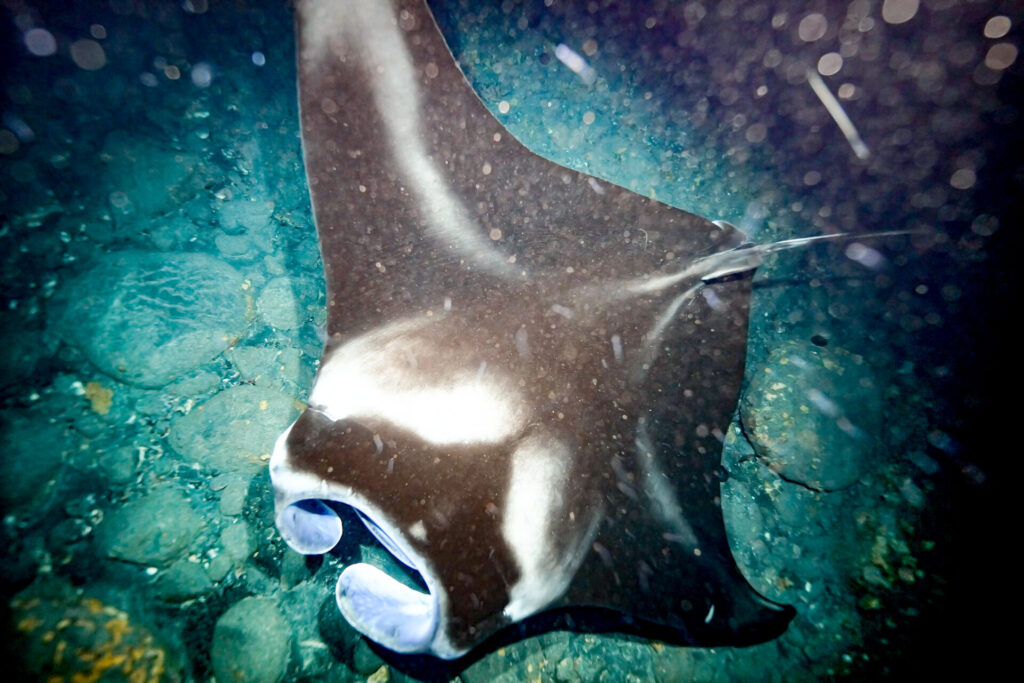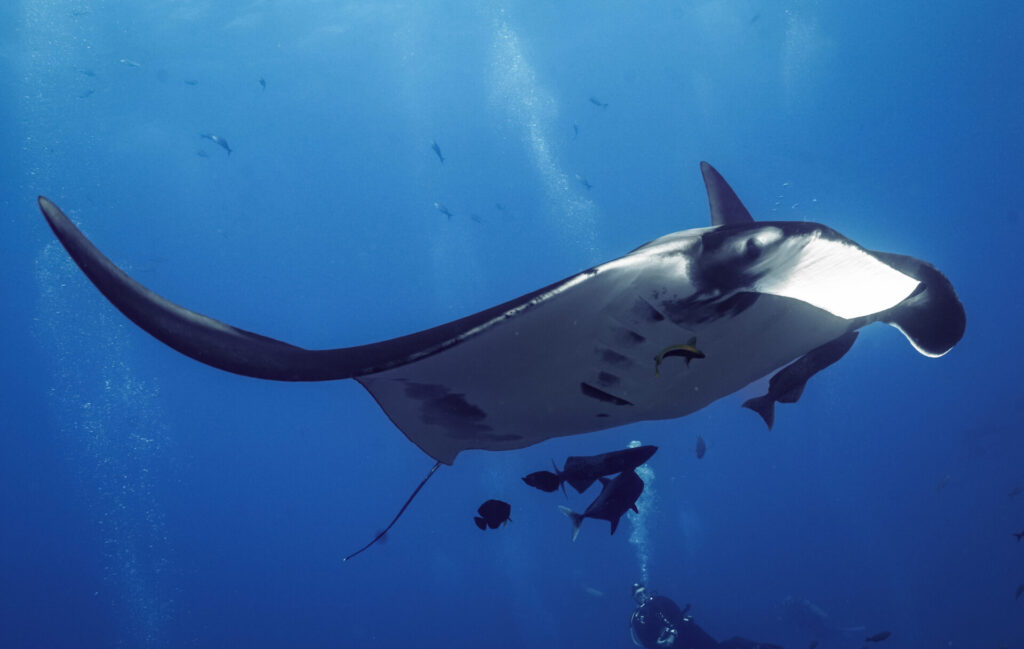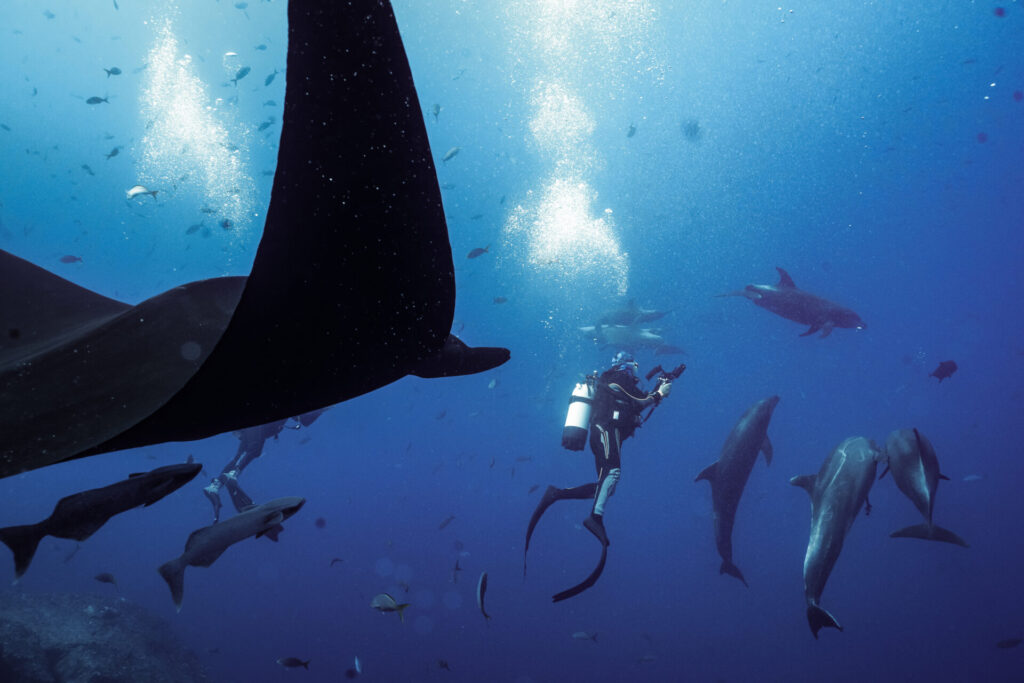A guide to manta ray photography
Manta ray photography is one of my all-time favorite hobbies. Manta ray dives or swims tend to be low stress and (hopefully) provide the chance to get close to a huge marine animal. It’s taken a lot of trial and error to feel like I’m capturing the kinds of manta ray photos that I see from true professionals. From choosing the right lens to understanding manta ray behavior, I’m here to hopefully save you some of the mistakes I made. Whether you’re an experienced underwater photographer or a beginner with a rented setup, these tips will help you make the most of your manta encounters.
Choosing the Right Lens: Zoom vs. Wide Angle
Your choice of lens can make or break your pictures of manta rays, so it’s crucial to understand the strengths and weaknesses of different options. On a standard reef dive I take my Tamron 28-75 mm. I find that this generally gives me enough flexibility to take photos of standard reef animals. With that being said, having the 14 mm prime gives the reef a really cool, other worldly view (so definitely take into account your artistic perspective and the kinds of shots you are looking to take.
I also never open my housing and change the lens on a boat (unless I’m on a liveaboard with lots of dry space); once I lock, load, and vacuum seal my camera housing she’s staying shut. On two tank dives like the Kona manta night dive, this means that I’m using my 14mm wide on both dives, which (for me) is ideal for the mantas (that will hopefully come close), but not for the reef.
Zoom Lens (24-70mm) for Manta Ray Photography
• Advantages: A zoom lens is versatile, allowing you to adjust your focal length to match the distance between you and any animal around you. This is especially useful in unpredictable underwater environments where mantas may come closer or stay farther away. I would take this lens to photograph a manta on a cleaning station, but not on the Kona manta night dive, where the mantas are seen feeding and I’m hoping that they will come closer.
• Disadvantages: If the manta ray comes close, you may not capture the sweeping grandeur of its wingspan. Generally, the zoom lens’ lose focus at the edges, so likely the 28-75 mm is closer to a 30-70mm.
Wide Angle Lens (14mm Prime) for Manta Ray Photography
• Advantages: A wide-angle lens excels in capturing the full scale of these majestic creatures, often including their environment for a more dramatic effect. This is ideal for close encounters, where you can capture the entire animal without cutting off any fins. Wide angle lens’ are great for anything that’s big and close, think whales, manta rays, tiger beach, but remember that anything that’s not huge will look very small (even compared to what you see with your naked eye).
• Disadvantages: Wide-angle lenses require you to get close to the subject, which isn’t always possible if mantas are shy or swimming around a cleaning station. No responsible dive company would ever let a dive swim on, over, or too close to a cleaning station.
In summary: If you’re planning on seeing manta rays in an environment where they will be feeding and you’re hoping for a close encounter, bring a wide angle lens (if you can, all the gear is expensive, so if you don’t have a wide angle or a zoom, do not fear, you can generally still take great photos with the lens you’ve got)). If you think it’s more likely you’ll see them at a cleaning station, then bring the zoom.
Manta Ray Photography at Cleaning Stations vs. Feeding
Manta rays behave differently depending on whether they’re cleaning or feeding. Understanding these differences will help you anticipate their movements and plan your shots.
At Cleaning Stations
Cleaning stations are special rocks or coral configurations where manta rays congregate. Many operators describe them as underwater “spas” where mantas pause while cleaner fish remove parasites from their skin, but I learned on my trip with the Manta Trust that manta rays can also use cleaning stations to thermoregulate and mating/social purposes.
Behavior to Expect: Mantas hover or glide slowly in circles, providing excellent opportunities for static, well-composed shots. I got a shot with manta rays and eagle rays at a cleaning station in the Maldives.
Tips:
- Seeing manta rays at cleaning stations is generally done on scuba (not snorkel).
- Maintain a respectful distance to avoid getting too close to the cleaning station. Follow your dive guide’s instruction about where to position yourself.
- Many cleaning station dives will use a reef hook, if that’s the case, hook in and do your best to relax and enjoy the show. This will also give you the stability to change your setting more easily.
- Generally, mantas are not at cleaning stations to feed, so these aren’t the encounters to hope for big, open mouth photos.
- If the mantas are moving more slowly, you can slow down you shutter and play with different settings.
During Feeding
When feeding, manta rays perform dramatic barrel rolls and swoops to capture plankton. Mantas eat plankton and will follow the food.
Behavior to Expect: Faster movements, often in groups.
Tips:
- Keep your shutter on 250 or higher and use continuous shooting mode to capture multiple frames as the mantas move (think sport action mode)
- On a manta night dive, bring bright lights. The lights will attract the plankton, which will bring the mantas in close. If your dive light is brighter than the lights the boats are providing, you may become quite popular.
- Use arms to position your lights further away from your dome and angle them out. This will help avoid lighting up the plankton. Check the lighting in your first couple shots to make sure there isn’t a dark spot in the middle.
- Feeding mantas can be seen on scuba or snorkel (depending on the location). I’ve seen mantas feeding on snorkel in Mexico, Indonesia, and Kona.
- Keep shooting! Never think you got the shot. The viewfinder on your camera underwater is too small for you to see what’s really in focus.
- If you’re in the right place at the right time, you may also get to see whale sharks. I’ve had this happen off of Isla Mujeres, Mexico (Hawaii does not have a lot of whale sharks, so this generally is not to be expected in Kona) and I think it could happen in the Maldives. Whale sharks also eat plankton, so they are sometimes in the same place at the same time. As I say, always better lucky than good.
Manta Ray Photography on the Kona Night Dive
Manta Ray Photography at night can be magical, but it comes with challenges like backscatter (light reflecting off particles in the water) and dense plankton. I’ve done the Kona manta night dive 10 times, and I’ve had to learn more than one lesson the hard way. Here are some tips so that you can capture great images the first time!
For clear photos of mantas: In my experience, for clear photos of mantas without any plankton or backscatter, you need to turn your lights off and take photos of mantas illuminated by other divers. Pro – clear manta photos. Con – the mantas generally won’t swim towards you with their mouth open if your lights are off. I will generally swim from the boat to the dive site with my lights off (they are super bright and I don’t want to blind the other divers) and will then shoot the dive with my lights off at the beginning (this also helps preserve my light’s batteries) and (1) if mantas come, (2) the mantas seem to be getting close to divers and eating the plankton off of the diver’s lights, and (3) I’ve taken some shots I think I may be happy with, then I will turn my lights on in hopes that the mantas will come feed off of my plankton (I also know that I have brighter lights than most of the other divers because I brought my own).
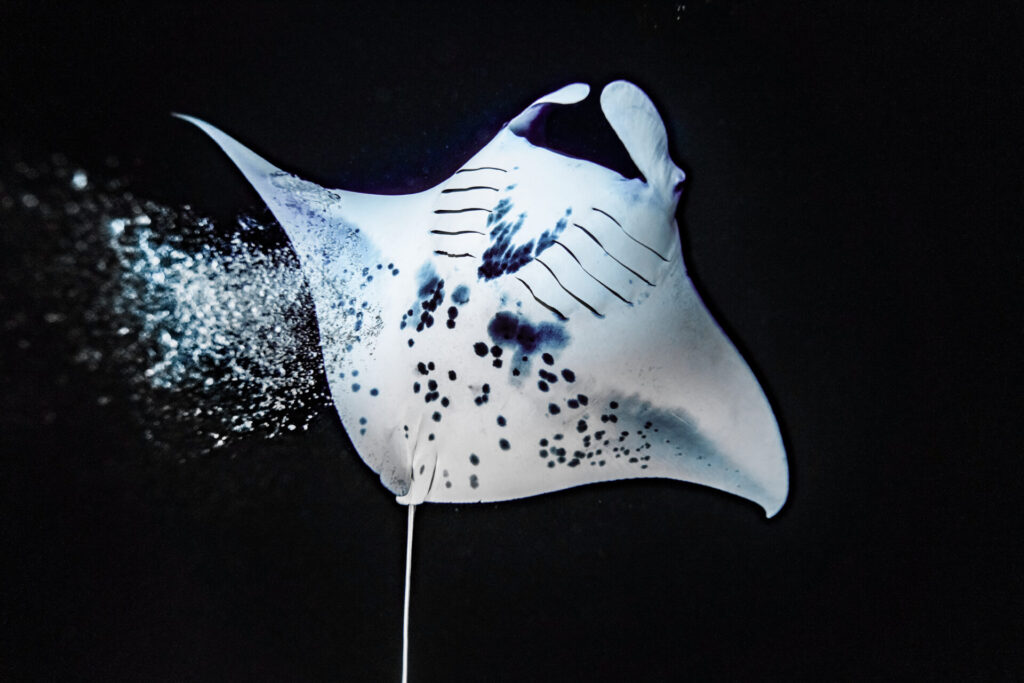
Strobes or Focus Lights: It’s a night dive, so you’ll need constant/video lights on the dive. I’ve never personally seen someone strobe the manta night dive. A few considerations: you may blind the people around you because the strobe will be a big flash at night; there’s a lot of light already in the water and the manta’s bellies are bright white, so you run the risk of overexposing; and you will need to be careful with the strobe placement to avoid all the backscatter (position your strobe lights slightly outward and angle them away from your lens. This reduces the likelihood of illuminating particles directly in front of the camera).
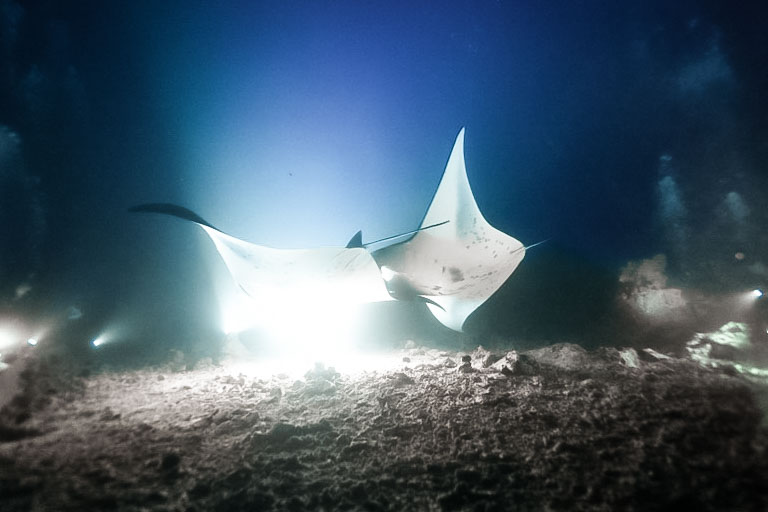
For the open mouth shot: If you’ve (1) worn a couple of extra lbs of weight to anchor you to the bottom, (2) brought bright lights (I have two 8,000 lumen lights) and (3) there are feeding mantas on the dive, you’ve successfully positioned yourself to get some great open mouth photos. The mantas will generally come from one of 3 directions: (1) to you from the big lights in the middle of the divers, (2) from the right or left as they eat the plankton over the other diver’s lights, or (3) from behind you (in which case you won’t see it coming). If you see the manta coming and it starts to open its mouth – stay clam, be a little brave and raise the camera up to take a photo of the inside of its mouth, and as the manta gets super close, lower the camera and duck your head a bit. Sometimes my go pro will brush the manta’s belly and I don’t want to make any contact, so I will lower my rig. Success! And you’ve had the closest encounter possible with a 1200-1500 lb manta ray!
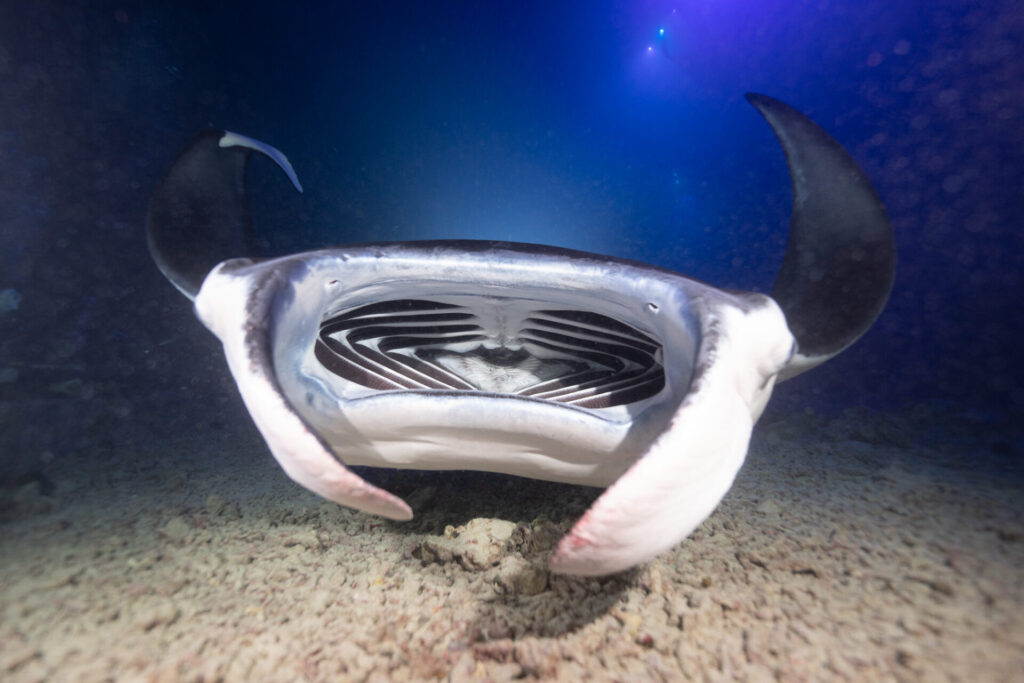
Don’t:
- Breath quickly or heavily. The manta will swim very close over your head, so anything that makes you float up will increase the chances of a manta/diver collision. If you are slightly overweighted, then briefly holding your breath in while not changing your depth is an option (part of the briefing will be that you shouldn’t blow bubbles directly into the manta’s mouth). This moment always takes my breath away, so I think I always hold it a bit because I am literally in awe of what’s happening around me.
- Assume the manta is gone and pop up. I’ve had mantas do barrel rolls over my head (if there’s anything I wish I had video of, it’s this), so move slow and don’t pop up quickly.
- Think that’s the end. On a hot manta dive, the mantas may come in succession, so keep breathing slowly and calmly and look to see if any more are coming before you turn your go-pro off or try to review your photos.

